HISTORY 135F
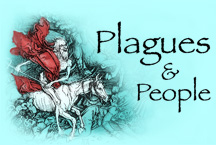
Infectious and
Epidemic Disease in History
Department of History
University of California, Irvine
Instructor: Dr. Barbara J. Becker
HISTORY 135F

Infectious and
Epidemic Disease in History
Department of History
University of California, Irvine
Instructor: Dr. Barbara J. Becker
|
Written During the Prevalence of a Yellow Fever Hot, dry winds forever blowing, |
William Penn (1644-1718) grew up in London. He was acquainted
with Samuel Pepys, who worked with his father, the renowned naval officer,
Sir William Penn. Here's what that sly wit Pepys had to say about
Penn's parents in his diary entry dated 28 December 1664:
Lady [Penn] ... is a well-looked, fat, short, old Dutch woman; but one that hath been heretofore pretty handsome, and is I believe very discreet, and hath more wit than her husband.London had developed in haphazard and often opportunistic ways. By the seventeenth century, the old city presented its half-million residents with many challenges:
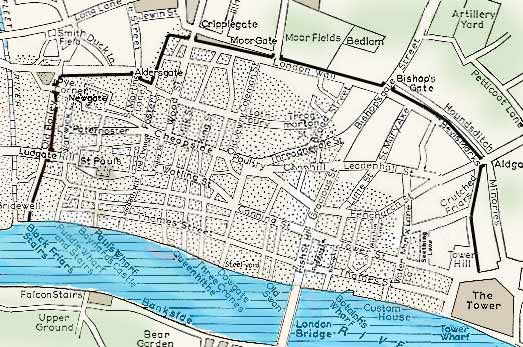 William Penn's London |
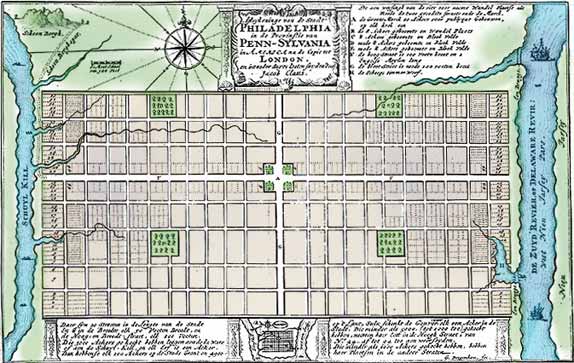 |
In 1681, Penn was granted a royal charter to plant a colony in America on the land situated west of the Delaware River, north of Maryland and south of New York. The king suggested naming this land Pennsylvania (Penn's Woods), in honor of Sir William Penn. In 1682, Penn established Philadelphia (City of Brotherly Love). He envisioned it as a utopian city:
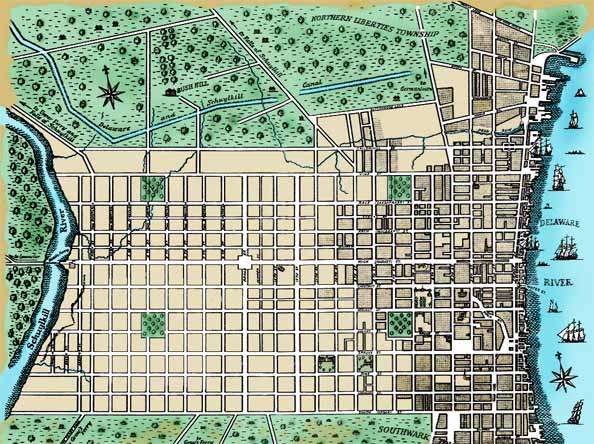
Philadelphia, c. 1793 |
Revolutionary Events in Historic
Philadelphia |
|||||||||||||
| 1776 | Declaration of Independence | ||||||||||||
| 1781 | Battle of Yorktown (defeat of Cornwallis marked the end of hostilities in the Revolutionary War) | ||||||||||||
| 1783 | Treaty of Paris (marked the official end of Revolutionary War) | ||||||||||||
| 1789 | Constitution goes into effect
George Washington elected president Congress meets in New York City |
||||||||||||
| 1790 | Philadelphia becomes temporary capital of the new nation
first US census taken: nearly 4 million counted [NOTE: The first U.S. Census included nearly every individual, but there were a limited number of classifications: free white males over age 16; free white males under 16; free white females; other free people; slaves. Only the names of the heads of households were recorded -- everyone else was just a number. Some leaders wanted more information to be gathered, but others objected that questions about individuals' occupation, property, religion... would constitute an invasion of privacy. Besides, the time and effort required to obtain and record the answers would cost too much!]
|
||||||||||||
| 1791 | site of permanent US capital selected on Potomac River | ||||||||||||
| 1792 | construction begins on White House | ||||||||||||
| 1793 | cornerstone of Capitol building is laid
yellow fever epidemic strikes Philadelphia
|
||||||||||||
The yellow fever will discourage the growth of great cities in our nation & I view great cities as pestilential to the morals, the health and the liberties of man. --Thomas Jefferson to Benjamin Rush (1800) |
|||||||||||||
|
|
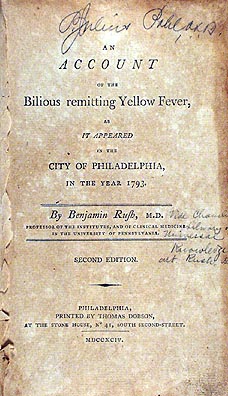 |
Benjamin Rush (1746-1813)
|
|
|
November 27, 1793 NEW YORK, November 21. ...The committee appointed to prevent the introduction and spreading of infectious disease in this city, are happy to confirm to their fellow citizens, the agreeable intelligence, that health is restored to the city of Philadelphia--at the same time they find it necessary to make it known. That, real danger is still to be apprehended from the bedding and clothing of those who have been ill of the malignant those who have been ill of the malignant fever.--The committee have received satisfactory information, that numbers of valuable, but infected, beds have been given to the nurses and attendants of the sick, many of which will probably be offered for sale--they are also assured, that attempts have been made to ship on freight considerable quantities of beds and bedding, from Philadelphia, for this city; which were prudently refused by the person applied to-- Therefore resolved, that in the opinion of this committee, it would be unsafe, and inexpedient, to admit the introduction into this city, of beds and bedding of any kind, or feathers in bags, or otherwise; also second hand wearing apparel of every species, coming from places infected with the yellow fever--and that whoever shall attempt so high handed an offence, against the lives and health of the inhabitants of this city, will justly merit their resentment and indignation. The committee likewise recommend to the inhabitants of those places in New Jersey, who have immediate communication both with Philadelphia and this city, to aid them in their endeavours to avert a calamity, which has already been attended with such melancholy consequences. And the masters of vessels coming from places lately infected are hereby notified, that unless they strictly comply with the recommendations of the committee, they will be obliged to perform quarantine, agreeable to law. By order of the committee,Note. The several Printers in this city and the neighbouring states are requested to insert the foregoing in their respective papers a sufficient length of time to make it generally known. |
|
August 6, 1794 From the Delaware Advertiser, printed at Wilmington, by Messrs. Adams & Smith, Saturday, August 2d, 1794. ALARM BELL.
In our last [number] we gave notice of the arrival of the Lark sloop, captain Guyer, of this port, from NEW ORLEANS, laden with Raw-Hides. We then could not make the proper enquiries, or remark on the impropriety of the captain--nor could we allow ourselves to criminate the health-officer, (if any) of this port; but, as friends to humanity, and servants to the public, we submit to their consideration the following queries--the result of general report: 1st. In consequence of the late unhappy visitation at Philadelphia, ought not every precaution that human wisdom could devise, be adopted, and enforced, to prevent the like calamitous event? 2d. Are not the pilots of the different branches, belonging to the Delaware, under strict regulations and official orders, to the following effect, viz. "That no vessel whatever, coming from the Streights, or from other parts beyond the seas, where the infection of the plague is apprehended, particularly from NEW ORLEANS, (where the yellow fever now rages) be permitted to land any of her crew, passengers or goods, not to break bulk, or come into port, previous to a visit from the Health-Officer, and a due performance of the usual quarantine?" 3d. Have any of these orders or injunctions been observed, in the smallest degree, by this vessel, notwithstanding her DIRECT ARRIVAL FROM THE CENTRE OF CALAMITY? 4th. Are not the crew very sickly; and have not two of them died of the Yellow Fever, and been buried, since their arrival to this port? 5th. If there was no cause to suppose any infection being aboard, or any dread of the contamination being found out, why should the silent hours of NIGHT, be chosen to land from this sloop, A LARGE QUANTITY OF PUTRID HIDES? These are of too serious import to pass unnoticed. If such exist, and escape investigation, we again ask, What is to be expected from the dreaded consequences? Too many scenes, distressing to the human heart, might be depicted, to awaken to a sense of danger, those whom official authority would warrant in the prevention of such arrivals, at least, until they were properly recognized and attested. TO THE PEOPLE OF PHILADELPHIA. The Editors of this Paper would recommend the most PRECISE EXAMINATION of EVERY SHALLOP [small open boat] approaching their Wharves, as it is to be much dreaded, that a market will be sought for the above article, by ANY CONVEYANCE that may be least suspected. We think it a duty we owe to humanity--to the tender and affectionate ties of society, thus to ALARM OUR NEIGHBOURS OF THE APPROACHING PESTILENCE; if it turns out contrary, we will not feel ourselves blameable, by rousing the attention of THE PEOPLE to their own welfare and happiness. ADAMS & SMYTH. |
|
September 2, 1795 Extract of a letter from New York, dated the 28th August, 1795. "A kind of fever has appeared, which has carried off about 60 people since its first beginning; yet it does not appear to be that kind of fever which raged last in Philadelphia, but how it may turn out God only knows. However for precautions's sake, Mr. C. and myself have provided a place of retreat for our and Mr. C's families, about ten miles from town--hope, however, we may not want it. This fever has its seat in Water street, where it broke out, and none have or had it but took it there.--Not one of our congregation has been taken with it; but a person of Dr. Kenzie's Church is dead of it, who lived in the vicinity of Peck's slip. I mention this to remove your fears of its being spread so much as we hear it is represented." |
|
September 2, 1795 In the Name and by the Authority of Commonwealth of Pennsylvania.
A PROCLAMATION. WHEREAS the Board of Inspectors of the Health Office of Philadelphia have reported to me, that it appears from authentic information to them exhibited, that an infectious or contagious disease exists in the city of New York, in the state of New York, and that there is reason also to believe that a similar disease exists in the town of Norfolk, in the State of Virginia, so that the safety and health of the Citizens of Philadelphia require a stoppage of intercourse with the said infected places: THEREFORE in pursuance of the duty in such case on me enjoined by law, but with a sincere regret for the unhappy occasion, I the said THOMAS MIFFLIN, Governor of the said Commonwealth, Have deemed it expedient to issue this Proclamation, Hereby prohibiting for the term of one month, or until such prohibition shall he by Proclamation lawfully revoked, all intercourse between the said city of Philadelphia and the said city of New York, and the said Town of Norfolk, and any place or places within five miles thereof respectively, as well by land as by water, UNDER THE PENALTY OF THREE HUNDRED DOLLARS, to be recovered from, and paid by, each and every person transgressing the said prohibition, in manner hereafter specified, agreeably to the terms and directions of the Act of the General Assembly, in such case made and provided.-- AND to the intent that suitable and efficient measures may be taken and pursued, for carrying into effect the said Prohibition, I have further deemed it expedient HEREBY to request that as well the Mayor, Aldermen and other Officers of the City, as the Inspectors of the Health-Office of the Port of Philadelphia, shall and will, with all possible vigilance and lawful authority and power, guard the various avenues or entrances into the said City of Philadelphia, by land and by water; so that any person, or persons, having been in the said city of New York or the said town of Norfolk within the space of ten days, and attempting to transgress the said prohibition, by approaching nearer to the said City of Philadelphia than five miles, shall be forthwith remanded to the place, or places, whence such person or persons respectively came, or shall be conveyed (at the discretion of the said Mayor and Aldermen, or of the said Inspectors) to the Hospital on State Island, and there kept as long as the case may require-- AND all Citizens, particularly those who have been in any wise concerned in, or shall be acquainted with, the intercourse between the said City of Philadelphia, and the said infected places, are earnestly exhorted and enjoined to give to the Mayor, or some other Magistrate of the said City, or to the Inspectors of the Health Office, the earliest information of any and every attempt, which shall be made to transgress, or evade the prohibition aforesaid, in order that the offender and offenders may be dealt with according to law. Given under my hand and the great seal of the state at Philadelphia, this thirty-first day of August, in the year of our Lord one thousand seven hundred and ninety-five and of the commonwealth the twentieth. THOMAS MIFFLIN. |
|
September 9, 1795 A Letter from New York: The Governor of Pennsylvania has issued his Proclamation, prohibiting all intercourse by land or water, with New York, and Norfolk, for the space of one month, or until the order shall be revoked, under the penalty of 300 dollars. The prohibition of intercourse between this city [New York] and Philadelphia is a proceeding very singular, and deserves severe animadversion. It is a measure that, to say the least, wears the aspect of a most unfriendly disposition, as it naturally tends to create unnecessary fears abroad, which may occasion an order for our vessels to perform quarantine in foreign ports, to the great injury of our trade. It seems, the Board of Health in Philadelphia, reported to the Governor the existence of a contagious disease in this city, on the authority of private letters, without ever writing to our Health Committee for a state of facts. This is a most extraordinary proceeding, when the reports of our committee have repeatedly informed the public, that the epidemic now prevailing, exhibits no decisive evidence of a specific contagion. Scarcely in one instance has an attendant on the sick taken the disease. This fact was known to the board of Health and the Governor of Pennsylvania, and yet the world is to be alarmed for the safety of Philadelphia, when the disease has not proved contagious enough to occasion any general alarm in New York. The disease is almost wholly local. Most parts of the city are entirely free from it. But one person died yesterday, and not more than five or six dangerously ill. In the name of common sense, must all the business of New York be impeded, by the ill timed enquiries of Philadelphia? Is this a generous return for five thousand dollars raised in New York to assist the suffering poor of Philadelphia during their calamity? When dangers become real, will not the citizens of New York be alarmed? Let the public judge. The epidemic of this city is not a new disease. It is a disease that occurs, more or less at this season in most of our sea ports. It is not the disease that should occasion alarm, but its contagion, which depends mostly on local causes. That contagion does not appear; when it does we will seek safety ourselves, and inform our brethren in Philadelphia. |
|
September 9, 1795 From the New York Gazette, &c.
COUSINS, We are all popping off here like rotten sheep. Two hundred carcases have been buried on the battery--500 hanged for fear of catching the Yellow Fever, and about 35 or 40 guillotined--all the windows in town are broken by the firing of cannon--several of our seven story houses have fallen down SLAM BANG of their own accord--federal hall has got a FIT OF THE FIDGETS, and two yearling pigs have died of the measles--pray send us about 100,000 dollars, to stop the contagion, and it may compensate us in some measure for an attempt to make our vessels ride a 40 days quarantine in European ports. NEW YORK. |
|
September 9, 1795 A letter from an eminent Physician of the City of New York, to Doctor Mease, Resident Physician of the Port of Philadelphia, dated: New York, August 31, 1795 Dear Sir,
If you wish any further information, or if any thing should turn up, I will communicate it with great pleasure. I am, with much esteem, |
|
MALARIA (see MIASMA), bad air.
Since the more systematic and microscopical investigation of various diseases, it has been shown that many other diseases, some of which are contagious, are produced by poisoned, infected, or bad air--in other words, by malaria. Air impregnated or polluted by sewer gas is the malaria productive of putrid sore throat or putrid fever (diphtheria), and perhaps the origin of scarlet fever.... It is thought by some that the term malaria should be restricted to marsh miasm, saying that air which is infected with the seeds of any disease ... but it is fairly conservative and proper to regard as malaria all air which is infected by the products of organic decomposition and putrefaction, whether vegetable or animal, and which in their origin may be so traced, although after being generated they may be contagious. MIASMA.
It is clearly neither heat nor moisture, for the crews of clean ships, when cruising in the tropics at a distance from land, are usually very healthy; nor is it any known gas extricated from the marsh, for the gases collected by stirring up marshes ... may be inspired without giving rise to any symptoms resembling those produced by malaria. It may be regarded as an established fact that the noxious agent is a product of vegetable decomposition occurring under certain conditions of heat and moisture.... Although moisture is necessary to the evolution of miasmata, an excess of it often acts as a preventive, and by impeding the access of atmospheric air retards or prevents decomposition. This explains the apparent anomaly of an uncommonly rainy season producing opposite effects in different localities, sometimes not far distant from one another.... Chemistry has hitherto failed in detecting any special ingredient to which the air evolved by marshes owes its poisonous qualities. The air collected in the most poisonous districts gives, on analysis, the same gases existing in the same proportions as normal air, nor ... does it give evidence of the presence of any organic body.... [I]t is found by experience that those who go out of their houses only during the day, after the morning fogs have dispersed, and before the evening mists appear, often escape the bad effects; and a full meal, with a few grains of quinine, should be taken before exposure to the morning air by travelers in a malarious district.... Dr. Wood of Philadelphia has pointed out the extraordinary and very important fact, that miasmata are neutralized, decomposed, or in some other way rendered innocuous by the air of large cities.... What it is in the air of the city which is thus incompatible with malaria, is unknown, but very probably it is connected with the results of combustion, for the fire and smoke of camps are asserted to have had the same effects. |
Tropical Disease and the Spanish-American War (1898) |
Casualties:
Acquisition of new territories (Philippines and Cuba)
50,000 US troops stationed in Cuba
|
Hypothesized causes of yellow fever:
|
| 1878 | Patrick Manson (1844-1922) finds that mosquitoes transmit the parasitic disease filariasis. |
| 1880 | Charles-Louis-Alphonse Laveran (1845-1922) observes
plasmodium
falciparum, the parasite that causes malaria.
Still unclear how the parasite enters the body. |
| 1881 | Carlos Juan Finlay (1833-1915) suggests mosquito, Aedes aegypti, may be vector for yellow fever |
| 1892 | Theobald Smith (1859-1934) and Frederick Kilbourne show that ticks (Boöphilus annulati) spread the parasitic disease "Texas Fever" in cattle. |
| 1894 | Patrick Manson finds that sleeping sickness (trypanosomiasis) is transmitted by the tsetse fly. |
| 1897 | Ronald Ross (1857-1932) demonstrates that Anopholes gambia is the agent by which malaria is transmitted. |
| 1900 | Walter Reed (1851-1902), James Carroll (1854-1907), Aristides Agramonte (1868-1931), and Jesse W. Lazear (1866-1900) show that Aedes aegypti transmits yellow fever. |
Research on human subjects to develop a yellow fever vaccine was halted in 1901 after the death of volunteer Nurse Clara Louise Maass. For decades, the control of insect-borne diseases was managed through control of the insect vectors: mosquito netting; window screens; limiting outdoor activity to hours when insects are not active; restricting insect access to sources of standing water; and modfiying the environment to interrupt insect reproductive cycles. In addition, malarial symptoms continued to be relieved through the
use of quinine, a toxic alkaloid made from the bark of the cinchona plant
(Peruvian bark).
|
(complex process; stages not fully identified and understood until 1948) |
|
| Mosquito to human host: | |
|
|
|
|
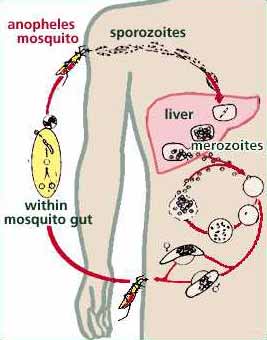
|
|
In human host:
|
|
| Merozoites in red blood cells take on two forms: | |
sexual (human host to mosquito):
|
asexual (in human host):
|
Mosquito to human host:
|
|
Tropical Disease and the Panama Canal |
|
Research to control the spread of tropical disease was motivated by US territorial expansion, and the desire to construct a navigable route connecting the Atlantic and Pacific oceans across the tropical North/South American isthmus. Beginning in 1882, the French launched an ambitious project to do just that. The plan was for a sea-level canal to be dug across the Colombian province of Panama near the path of the railroad that had been completed in 1855. Investors had every reason to be optimistic. The man in charge of the project was none other than Ferdinand Marie de Lesseps (1805-1894), the builder of the 107-mile Suez Canal which had been in operation since 1869. It was estimated that the Panama project would cost $132 million dollars and take about 12 years to complete. But the project ended in failure in 1888. In six years, only 11 miles of the canal's proposed 51-mile length had been dug at a cost of $287 million dollars and 20,000 lives! Shortly after assuming office in 1902, Theodore Roosevelt orchestrated the purchase of the rights to the canal and the US embarked on its own construction project in 1904. Extensive efforts at mosquito eradication eliminated the threat of yellow fever in the region by 1905. The first ship steamed through the canal on August 15, 1914, but a war-crazed world was too busy to notice. |
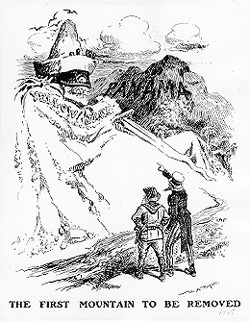
Ever the "Rough Rider," President Teddy Roosevelt looks on as Uncle Sam points to the main obstacle to the successful construction of a canal across the Panamanian isthmus: "Yellow Jack." |
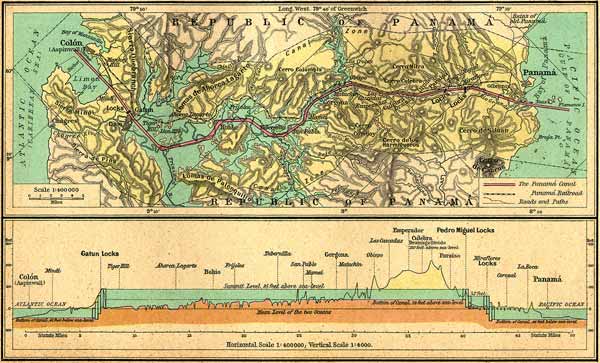
The 51-mile journey through the Panama Canal from the Atlantic to the Pacific takes about 9 hours. Lake Gatún, which sits at an elevation of 85 feet above sea level, was created by the damming of the Chagres River. A system of locks on each end of the canal lifts and lowers the ships through the variations in elevation. |
Yellow fever virus |
|
| 1927 | yellow fever virus is isolated from a patient. |
| 1928 | Adrian Stokes, Johannes Bauer, and N. Paul Hudson discover that rhesus monkeys are susceptible to yellow fever virus making it possible to conduct further research on a yellow fever vaccine using non-human subjects. |
| 1937 | Max Theiler develops successful yellow fever vaccine. |
 |
| Go to: |
|
|